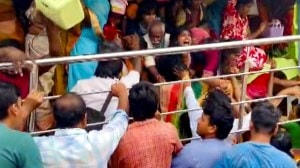Delhi to resonate in Bihar? In the state going to polls next, a shift in the wind
In the NDA camp, BJP will flex new electoral muscle; in Mahagathbandan, Congress will find its space shrinking
 Chief Minister Nitish Kumar and Rashtriya Janata Dal (RJD) leader Tejashwi Prasad Yadav. (Source: FB)
Chief Minister Nitish Kumar and Rashtriya Janata Dal (RJD) leader Tejashwi Prasad Yadav. (Source: FB)As dust settles on the fierce electoral battle in Delhi won comprehensively by the BJP, political focus is set to shift to Bihar, the next big fight of this year where Chief Minister Nitish Kumar is bidding for a historic fifth term and RJD leader Tejashwi Yadav hopes to cash in on two decades of anti-incumbency.
Bihar is likely to go into polls in November this year, with the BJP here too seen as in a dominant position in its alliance with the JD(U) compared to the RJD-led Mahagathbandhan, which includes a beaten Congress and the Left. Given the momentum generated by BJP victories in the tough contests of Maharashtra, Haryana and Delhi, the NDA has set an ambitious target of winning 225 of the 243 seats in Bihar.
The Congress has also turned its attention to Bihar, with Rahul Gandhi making a day-long visit to Patna on the day Delhi was voting, on February 5. It was his second visit to the state in 18 days.
Prime Minister Narendra Modi is expected to visit the state on February 24 to inaugurate some development projects and address a farmers’ gathering.
The Delhi results are set to rub off on Bihar, particularly in seat-sharing talks within the two alliances in the state. With three back-to-back victories behind it, the BJP is likely to push for a greater share of seats within the NDA. The JD(U)’s tally in 2020 of just 43 of the 115 seats it contested, leaving it far behind the BJP’s victory in 74 of 110 constituencies, would be a starting point for the BJP.
JD(U) sources said the party will push back pointing out that it performed better than the BJP in last year’s Lok Sabha polls where, while both parties won 12 seats each, the JD(U) had a better strike rate.
Similarly, in the Mahagathbandhan, the Congress is left with few bargaining chips after its third poor performance on the trot in states. The RJD is unlikely to be persuaded to share many seats with the Congress now. The Congress position was already shaky since in 2020, it won just 19 of the 70 seats it contested. The RJD, in contrast, won 80 of its 144, emerging as the single-largest party.
Both the JD(U) and RJD have been in election mode for a while. Nitish Kumar launched a ‘Pragati Yatra’ on December 23 last year, to cover the entire state in phases, and is holding separate yatras for specific groups, such as the ‘Nari Shakti Rath Yatra’ and ‘Karpoori Rath Yatra’ aimed at women and the extremely backward classes who are seen as core Nitish supporters.
Amid the Constitution pitch raised by the Opposition, the party is holding an ‘Ambedkar Rath Yatra’, which aims to cover all the districts and establish a dialogue with Dalits. An ‘Alpsankhyak Rath’ is on the move to engage with Muslims.
All the yatras are expected to wrap up by the end of this month.
The RJD too is on the streets. For the past several months, Tejashwi, who has been formally named his successor by father and RJD founder Lalu Prasad, has been touring Assembly constituencies, meeting party workers and articulating the party’s promises to the people as part of a programme called ‘Karyakarta Darshan Sah Samwad Karyakram’.
In line with schemes that have now stood the test of polls in other states, the RJD has announced monthly payments to women from poor families amounting to Rs 2,500 under a ‘Mai Bahin Maan Yojana’. It is also promising 200 units of free electricity on the lines of the now-ousted Aam Aadmi Party government in Delhi, and to increase pension for the elderly.
Job creation and reining in migration are other issues the party is focusing on.
While Nitish has beaten anti-incumbency now in successive elections, the ailing JD(U) supremo is seen as a spent force with dented credibility due to his frequent switches between the NDA and Mahagathbandhan, always ensuring he himself stays in power.
However, the NDA has got a fresh wind on the strength of the resurgent BJP, the bonanza for Bihar in the recent Union Budget by the Modi government, and the blow to the Mahagathbandhan from the misfires of the INDIA bloc.
If in last year’s Union Budget, the Centre allocated close to Rs 70,000 crore for various infrastructure, power and flood mitigation projects to Bihar, this time saw the announcement of a Makhana Board to kickstart the food processing industry in Bihar, and a Kosi canal for flood mitigation.
This is expected to stave off the criticism against the Nitish government of not managing to push his “vikas” plank beyond better roads and electricity, and generate jobs, which is the biggest item on the RJD’s agenda.
What also continues to work in Nitish’s favour are the bad memories the state has of the last RJD reign in Bihar, led by Lalu, marked by muscular Yadav dominance and law and order crises.
In 2020, Tejashwi’s success in steering the RJD towards a near shot at power, despite being a relative greenhorn at the time, had generated enough momentum to sustain the party till the Lok Sabha polls last year. While the NDA won 31 of the 40 seats in Bihar, this was a fall from its sweep of five years before. Plus, the RJD again came out on top as the party with the highest vote share, at 22%.
However, that momentum is believed to have fizzled out since, reflected in November 2024’s bypolls to four seats, which were all won by the NDA, including two RJD bastions.
One reason is the growing traction of poll strategist-turned-politician Prashant Kishor’s party Jan Suraaj, who cornered around 10% of the votes in the bypolls, its first electoral contest. Jan Suraaj candidates got more votes than the margin of defeat of RJD candidates in its two strongholds of Belaganj and Imamganj.
Before launching his party, Kishor was on a padyatra across the state for two years. His recent hunger strike over the BPSC exam row in Bihar, hitting a nerve when unemployment is among the biggest issues in the state, has added to the buzz about the party.
The NDA insists the Jan Suraaj will hurt the RJD more as it will split the anti-Nitish vote; Kishor has been attacking the CM in his political campaign.



- 01
- 02
- 03
- 04
- 05




























